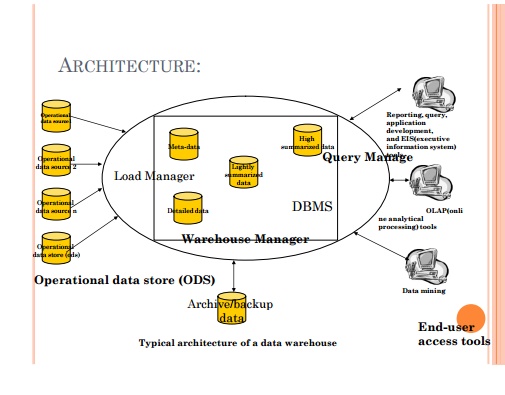Chapter: Business Science : Information Management : Database Management Systems
Data warehouse
Data warehouse
Data
warehouse is data management and data analysis
Goal: is
to integrate enterprise wide corporate data into a single reository from which
users can easily run queries
Benefits
The major
benefit of data warehousing are high returns on investment.
Increased
productivity of corporate decision-makers
Problems
Underestimation
of resources for data loading
Hidden
problems with source systems
Required
data not captured
Increased
end-user demands
Data
homogenization
High
demand for resources
Data
ownership
High
maintenance
Long-duration
projects
Complexity
of integration

Main components
Operational data sources - - > for the DW is supplied
from mainframe
operational data held in first generation hierarchical and network databases,
departmental data held in proprietary file systems, private data held on
workstaions and private serves and external systems such as the Internet,
commercially available DB, or DB assoicated with and organization‘s suppliers
or customers.
Operational datastore(ODS) - - > is a repository of current and integrated
operational data used for analysis. It is often structured and supplied with
data in the same way as the data warehouse, but may in fact simply act
as a staging area for data to be moved into the warehouse.
query manager - - > also called backend
component, it performs all the operations associated with the management of
user queries. The operations performed by this component
include directing queries to the appropriate tables and scheduling the
execution of queries
end-user access tools - - > can be categorized into
five main groups: data reporting and query tools, application development
tools, executive information system (EIS) tools, online analytical
processing (OLAP) tools, and data mining tools.
Data
flow
Inflow- The processes associated with
the extraction, cleansing, and loading of the data from the source systems into
the data warehouse.
upflow- The process associated with
adding value to the data in the warehouse through summarizing, packaging ,
packaging, and distribution of the data.
downflow- The processes associated
with archiving and backing-up of data in the warehouse.
Tools
and Technologies
The
critical steps in the construction of a data warehouse:
Extraction
Cleansing
Transformation
after the
critical steps, loading the results into target system can be carried out
either by separate products, or by a single, categories:
code generators
database data replication tools
dynamic transformation engines
For the
various types of meta-data and the day-to-day operations of the data warehouse,
the administration and management tools must be capable of supporting those
tasks:
Monitoring data loading from multiple sources
Data quality and integrity checks
Managing and updating meta-data
Monitoring database performance to ensure efficient
query response times and resource utilization
Auditing data warehouse usage to provide user
chargeback information
Replicating, subsetting, and distributing data
Maintaining effient data storage management
Purging data;
Archiving and backing-up data
Implementing recovery following failure
Related Topics